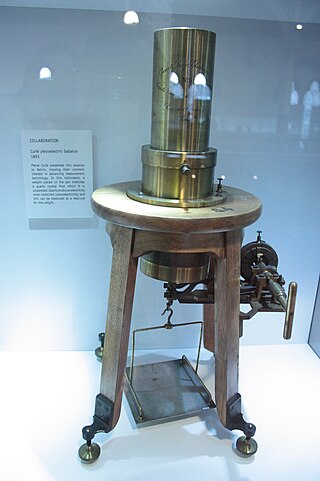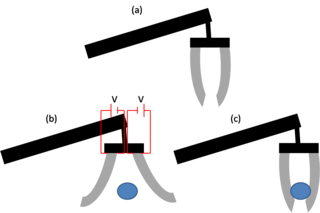
Piezoelectricity is the electric charge that accumulates in certain solid materials—such as crystals, certain ceramics, and biological matter such as bone, DNA, and various proteins—in response to applied mechanical stress. The word piezoelectricity means electricity resulting from pressure and latent heat. It is derived from Ancient Greek πιέζω (piézō) 'to squeeze or press', and ἤλεκτρον (ḗlektron) 'amber'. The German form of the word (Piezoelektricität) was coined in 1881 by the German physicist Wilhelm Gottlieb Hankel; the English word was coined in 1883.
A transducer is a device that converts energy from one form to another. Usually a transducer converts a signal in one form of energy to a signal in another. Transducers are often employed at the boundaries of automation, measurement, and control systems, where electrical signals are converted to and from other physical quantities. The process of converting one form of energy to another is known as transduction.
An actuator is a component of a machine that produces force, torque, or displacement, usually in a controlled way, when an electrical, pneumatic or hydraulic input is supplied to it in a system. An actuator converts such an input signal into the required form of mechanical energy. It is a type of transducer. In simple terms, it is a "mover".

Wear is the damaging, gradual removal or deformation of material at solid surfaces. Causes of wear can be mechanical or chemical. The study of wear and related processes is referred to as tribology.
In electromagnetism, electrostriction is a property of all electrical non-conductors, or dielectrics, that causes them to change their shape under the application of an electric field. It is the dual property to magnetostriction.

An electroactive polymer (EAP) is a polymer that exhibits a change in size or shape when stimulated by an electric field. The most common applications of this type of material are in actuators and sensors. A typical characteristic property of an EAP is that they will undergo a large amount of deformation while sustaining large forces.

A piezoelectric motor or piezo motor is a type of electric motor based on the change in shape of a piezoelectric material when an electric field is applied, as a consequence of the converse piezoelectric effect. An electrical circuit makes acoustic or ultrasonic vibrations in the piezoelectric material, most often lead zirconate titanate and occasionally lithium niobate or other single-crystal materials, which can produce linear or rotary motion depending on their mechanism. Examples of types of piezoelectric motors include inchworm motors, stepper and slip-stick motors as well as ultrasonic motors which can be further categorized into standing wave and travelling wave motors. Piezoelectric motors typically use a cyclic stepping motion, which allows the oscillation of the crystals to produce an arbitrarily large motion, as opposed to most other piezoelectric actuators where the range of motion is limited by the static strain that may be induced in the piezoelectric element.

In various contexts of science, technology, and manufacturing, an indicator is any of various instruments used to accurately measure small distances and angles, and amplify them to make them more obvious. The name comes from the concept of indicating to the user that which their naked eye cannot discern; such as the presence, or exact quantity, of some small distance.

A linear actuator is an actuator that creates linear motion, in contrast to the circular motion of a conventional electric motor. Linear actuators are used in machine tools and industrial machinery, in computer peripherals such as disk drives and printers, in valves and dampers, and in many other places where linear motion is required. Hydraulic or pneumatic cylinders inherently produce linear motion. Many other mechanisms are used to generate linear motion from a rotating motor.

An ultrasonic motor is a type of piezoelectric motor powered by the ultrasonic vibration of a component, the stator, placed against another component, the rotor or slider depending on the scheme of operation. Ultrasonic motors differ from other piezoelectric motors in several ways, though both typically use some form of piezoelectric material, most often lead zirconate titanate and occasionally lithium niobate or other single-crystal materials. The most obvious difference is the use of resonance to amplify the vibration of the stator in contact with the rotor in ultrasonic motors. Ultrasonic motors also offer arbitrarily large rotation or sliding distances, while piezoelectric actuators are limited by the static strain that may be induced in the piezoelectric element.

Piezo ignition is a type of ignition that is used in portable camping stoves, gas grills and some lighters. Piezo ignition uses the principle of piezoelectricity, which, in short, is the electric charge that accumulates in some materials in response to mechanical deformation. It consists of a small, spring-loaded hammer which, when a button is pressed, hits a crystal of PZT. This sudden forceful deformation produces a high voltage and subsequent electrical discharge, which ignites the gas.
The following outline is provided as an overview of and topical guide to machines:
A mechanical amplifier, or a mechanical amplifying element, is a linkage mechanism that amplifies the magnitude of mechanical quantities such as force, displacement, velocity, acceleration and torque in linear and rotational systems. In some applications, mechanical amplification induced by nature or unintentional oversights in man-made designs can be disastrous, causing situations such as the 1940 Tacoma Narrows Bridge collapse. When employed appropriately, it can help to magnify small mechanical signals for practical applications.

Micropumps are devices that can control and manipulate small fluid volumes. Although any kind of small pump is often referred to as a micropump, a more accurate definition restricts this term to pumps with functional dimensions in the micrometer range. Such pumps are of special interest in microfluidic research, and have become available for industrial product integration in recent years. Their miniaturized overall size, potential cost and improved dosing accuracy compared to existing miniature pumps fuel the growing interest for this innovative kind of pump.

Piezoresponse force microscopy (PFM) is a variant of atomic force microscopy (AFM) that allows imaging and manipulation of piezoelectric/ferroelectric materials domains. This is achieved by bringing a sharp conductive probe into contact with a ferroelectric surface and applying an alternating current (AC) bias to the probe tip in order to excite deformation of the sample through the converse piezoelectric effect (CPE). The resulting deflection of the probe cantilever is detected through standard split photodiode detector methods and then demodulated by use of a lock-in amplifier (LiA). In this way topography and ferroelectric domains can be imaged simultaneously with high resolution.
Space tribology is a discipline in the field of tribology which deals with tribological systems for spacecraft applications. Research in the field aims to design reliable tribological systems that can withstand the harsh environment of space.

A microscanner, or micro scanning mirror, is a microoptoelectromechanical system (MOEMS) in the category of micromirror actuators for dynamic light modulation. Depending upon the type of microscanner, the modulatory movement of a single mirror can be either translatory or rotational, on one or two axes. In the first case, a phase shifting effect takes place. In the second case, the incident light wave is deflected.

Kenji Uchino is an American electronics engineer, physicist, academic, inventor and industry executive. He is currently a professor of Electrical Engineering at Pennsylvania State University, where he also directs the International Center for Actuators and Transducers at Materials Research Institute. He is the former associate director at The US Office of Naval Research – Global Tokyo Office.
A microvalve is a microscale valve, i.e. a microfluidic two-port component that regulates the flow between two fluidic ports. Microvalves are basic components in microfluidic devices, such as labs-on-a-chip, where they are used to control the fluidic transport. During the period from 1995 to 2005, many microelectromechanical systems-based microvalves were developed.
Extreme tribology refers to tribological situations under extreme operating conditions which can be related to high loads and/or temperatures, or severe environments. Also, they may be related to high transitory contact conditions, or to situations with near-impossible monitoring and maintenance opportunities. In general, extreme conditions can typically be categorized as involving abnormally high or excessive exposure to e.g. cold, heat, pressure, vacuum, voltage, corrosive chemicals, vibration, or dust. The extreme conditions should include any device or system requiring a lubricant operating under any of the following conditions:











